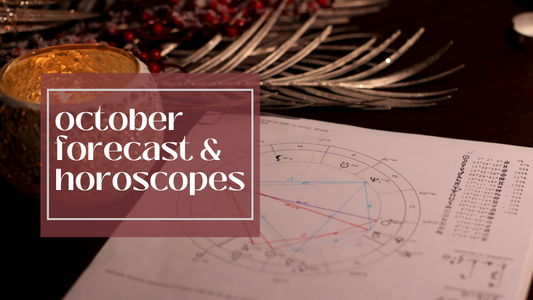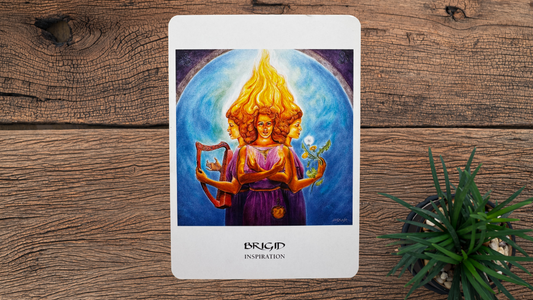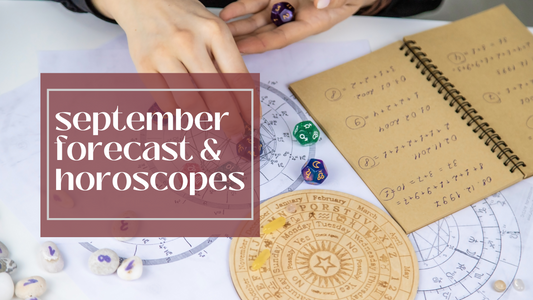
Kali: Mother Goddess of Destruction
Share
Kali is the most famous of the Hindu Goddesses. You will have seen Her fearsome image as goddess of destruction, darkness, and death. Her wild hair, blood-red tongue, necklace of skulls, and fierce eyes are hard to miss.
Kali is the destroyer of illusions, the breaker of ego, and the harbinger of endings. But to see Kali only as fearsome is to glimpse just one face of a deeply complex and multifaceted goddess. Kali also holds bold compassion, and radical liberation.
She is the shadow that makes light possible, both chaos and creation. A wild, numinous force that holds both destruction and potential in one incredibly powerful presence.

The Dark Mother: Who is Kali?
Kali is one of the oldest and most powerful goddesses in Hinduism and Tantric traditions. Her origins trace back over 1,500 years, with roots in ancient Sanskrit texts (or, more likely, in the goddess traditions that pre-date these texts) and evolving through rich layers of mythology, ritual, and devotion.
Her earliest major appearance is in the Devi Mahatmya (circa 5th–6th century CE), part of the Markandeya Purana, where she emerges as a fierce warrior goddess called forth to defeat the demon Raktabija. Since then, Kali’s presence has expanded through a wide range of texts, including the Kalika Purana and various Tantric scriptures that explore her as the embodiment of time, change, and liberation.
Today, Kali is worshipped across India - especially in the eastern states of Bengal, Odisha, and Assam - as well as in Nepal, Bangladesh, Sri Lanka, and in the global diaspora. Her devotion is deeply alive in temples, homes, and festivals, where she is revered as Kali Ma, the Mother who fiercely protects and liberates her children.
Kali’s Stories: Both Demon-Slayer and Compassionate Death-Mother
One of the earliest and most influential stories of Kali comes from the Devi Mahatmya, a foundational Hindu text composed around the 5th or 6th century CE. In this text, during a cosmic battle, the demon Raktabija possesses a terrifying power: from every drop of his spilled blood, a new demon is born. To defeat him, the goddess Durga summons Kali, born from Durga’s own rage and divine power. Kali spreads her tongue across the battlefield, devouring Raktabija’s blood before it can reach the earth, preventing his regeneration and ending his reign of terror.
But Kali’s battle-fury does not stop. Intoxicated by bloodlust, she begins a wild dance of destruction that threatens to unravel the world itself. To bring her back to awareness, her consort Shiva lies down in her path. When Kali steps on him and realises what she is doing, she stops.
From 18th-century Bengal, the poet-saint Ramprasad Sen gave voice to a radically intimate relationship with Kali through his deeply emotional devotional songs, known as Ramprasadi. In his poems, Kali is not only the fierce goddess of battle, but the tender mother, playful child, and divine beloved. She is the embodiment of awakening, not only through terror, but through love.

From one of his most beloved songs:
“Meditate on Kali! Why be anxious?
The night of delusion is over; it’s almost dawn.
The sun is rising, dispelling thick nets of darkness…”
Kali dispels illusion not with gentle persuasion, but through her fierce, uncompromising presence. And in that clarity, there is peace.
Another poem, Who in this world, opens with raw wonder:
“Who in this world can understand what Mother Kali really is?
The six systems of philosophy remain powerless to describe Her.
She is the life blossoming within the creatures of the universe…”
Ramprasad’s vision invites us to meet Kali not through doctrine, but through devotion and direct experience. She is the pulse of existence itself.
These stories and poems reveal Kali as far more than an indiscriminate destroyer. Over centuries, our understanding of her has evolved into a wide range of representations:
- Time and Death: Kali as the great destroyer of ego and illusion, the force of inevitable change.
- Liberator: The goddess who frees souls from samsara, the cycle of birth and rebirth.
- Mother: Devotees call her Kali Ma, the fierce mother who protects her children with wild love.
- Wild Feminine: She embodies rage, sexuality, and the primal power of nature unconstrained by social rules.
- Cosmic Force: Kali as the dynamic energy behind creation and dissolution. She is the Shakti to Shiva’s consciousness.
Ultimately, She is impossible to define with words, and must be met through personal experience.
Meeting Kali Today
Kali lives in temples, homes, and hearts across India and the global Hindu diaspora. Her festivals are celebrated with fierce devotion, particularly in Bengal during Kali Puja, where offerings, prayers, music, and ritual honour her presence. She is a goddess of a living tradition, and it is essential to approach her with deep respect for those who know her intimately.
For those of us outside of that tradition, meeting Kali requires humility. She is not a figure to be softened or made into something more palatable. Her wildness, her blood and fire, her uncompromising clarity - these are not quirks to be tamed, but truths to unravel.
At the same time, Kali is not only rage and destruction. Many devotees know her as Mother. She destroys to liberate. She cuts through illusion to bring awakening. She devours ego, but nurtures the soul.
Approaching Kali today can mean sitting with the parts of ourselves we fear the most: grief, rage, endings, truth. It can mean asking what needs to die, not in a morbid way, but in order for something new to be born. It might also mean unlearning the ways we have been taught to fear the feminine when she is powerful, unapologetic, and free.
If you feel called to work with Kali, take time to listen to voices rooted in her living traditions (I have linked some starting points below). Seek out teachers, writers, and practitioners from Hindu lineages. Honour and be inspired by the cultures she arises from.
You can also approach Kali directly. You don’t need to decorate your altar with skulls to impress her. Kali asks for your honesty. Your rawness. Your willingness to surrender something false in order to touch what is real.
She meets us not where we pretend to be, but where we are stripped bare.
A Gift and an Invitation
For those feeling the fierce pull of Kali, a free guide is available for you to download. Designed for printing or use in digital journaling apps like GoodNotes, it includes journal prompts, reflections, and simple practices to help you engage with Kali’s energy in your own life, with reverence, curiosity, and courage.
Inside the MoonWise Membership, we meet one goddess each cycle. Through journaling, ritual, devotion, and gentle daily practice, we honour the sacred feminine in her many forms.
If you are walking through endings…
If you are ready to release what no longer serves…
If Kali is rising in your life…
You’ll find her waiting for you here.
Follow the Thread
For those who wish to explore Kali’s depths further, here are a few starting points:






